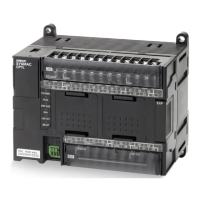A
Appendix
A-1 Channel/Relay Numbers
104 SYSMAC CP1L/CP1E Introduction Manual
●Condition Flags
Condition flags are used to reflect the processing results during or after the
execution of instructions. Whether a flag is used or not will depend on the
instruction. These flags are used in ladder programs as contacts.
Name Label In CX-P Function
Error flag ER P_ER
• Turns ON when an instruction handling BCD
data attempts to execute using non-BCD data.
• Turns ON when an operand value specified by
the instruction is invalid (e.g. a value outside
the work area).
Access error flag AER P_AER Turns ON when unauthorized access is
attempted on an area that is not meant to be
accessed.
Carry flag CY P_CY
• Turns ON when the number of digits is
increased or decreased as a result of
executing an arithmetical instruction.
• Data shift instructions and some arithmetical
instructions may handle the carry as part of
their processing.
Equals flag
=
P_EQ
• Turns ON when data comparison returns an
"equal".
• Turns ON when data becomes 0 as a result of
calculations or transfers.
Unequal flag
< >
P_NE Turns ON when data comparison returns an
"unequal".
Greater than flag
>
P_GT Turns ON when data comparison returns
"data1>data2".
Greater than or
equals flag
>=
P_GE Turns ON when data comparison returns
"data1>=data2".
Less than flag
<
P_LT Turns ON when data comparison returns
"data1<data2".
Less than or
equals flag
<=
P_LE Turns ON when data comparison returns
"data1=<data2".
Negative flag
N P_N Turns ON when the MSB becomes 1 as a result
of calculations.
Overflow flag OF P_OF Turns ON when the calculation result overflows.
Underflow flag UF P_UF Turns ON when the calculation result
underflows.
Always ON flag ON P_ON Remains ON at all times. Used as an execution
condition for instructions that cannot be
connected directly to the bus bar.
Always OFF flag OFF P_OFF Remains OFF at all times.

